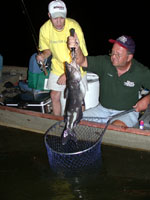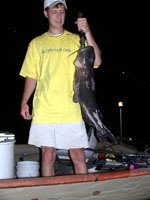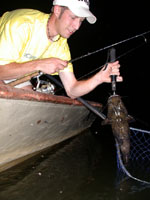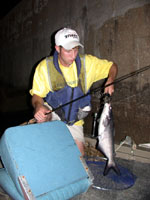
|
Features
|
|
|
|
Books
|
|
|
|
Fun & Games
|
|
|
|
Contact Us
|
|
|
John's Journal... Entry 163, Day 4
HOW AND WHERE TO CATCH CATS AT NIGHT
How To Rig For Catfishing
 EDITOR'S
NOTE: Jerry Crook of Gardendale, Alabama, a veteran Tennessee River angler,
has over 22 years of experience there. Crook operates Tailrace Guide Service
that focuses on live-bait fishing to provide his clients with a variety
of opportunities to catch several species of fish in a day's outing.
EDITOR'S
NOTE: Jerry Crook of Gardendale, Alabama, a veteran Tennessee River angler,
has over 22 years of experience there. Crook operates Tailrace Guide Service
that focuses on live-bait fishing to provide his clients with a variety
of opportunities to catch several species of fish in a day's outing.
Question: Most people use really heavy tackle, strong
rods and hefty reels to catch catfish. Tonight we caught catfish from
10- to 18-pounds each. How did we rig?
Crook: We used spinning rods and 10-pound-test Silver Thread line made
by Excalibur. You really can feel the bite through this co-polymer line,
which is one of the most
abrasion-resistant lines I've ever used. Before, I've caught stripers
as big as 47 pounds on Excalibur 17-pound-test Silver Thread line.
 Question:
Let's talk about the care of the line when you catfish. Do you check your
line after every fish, and if you do, for what are you looking?
Question:
Let's talk about the care of the line when you catfish. Do you check your
line after every fish, and if you do, for what are you looking?
Crook: Since fishing for catfish in this area means you'll fish around
rocks, you want to be real conscious of your line quality. After every
catfish I catch, I'll run my fingers up my line as high as 2 or 3 feet
to make sure there are no nicks anywhere on that line.
Question: The catfish also will roll in the line and
use their pectoral and dorsal fins with their really sharp, bony spurs
on them to cut the line. Catfish also have very abrasive mouths that will
nick and cut your line, won't they?
Crook: Yes. If you have a catfish that's deeply hooked in the mouth, especially
a bigger fish that has the hook way down deep, you'll really want to change
and cut your hook off and retie it again. Catfish have bony, rough-edged
teeth inside their mouths -- much rougher than sandpaper. So, catfish
will wear through your lines. If you do get a big fish on your line, don't
horse that fish in, but instead get it in quickly. The longer the fight
goes on, the less chance you'll have of catching the fish.
 Question:
What size leads do you use, how far from the hook do you tie on the leads,
and what type of lead do you use?
Question:
What size leads do you use, how far from the hook do you tie on the leads,
and what type of lead do you use?
Crook: On a split-shot rig, I use a big musketball shot probably close
to a 1/2-ounce. I rig it up 8 inches above the hook, a No. 2 Eagle Claw
Pattern 84.
Question: Why do you like that hook?
Crook: If you put a hook bigger than that in a threadfin shad, the hook
will crush the threadfin's head. We use live baits. Right now the cats
are feeding on live shad, and we're trying to match their diet as closely
as possible. I use that No. 2 hook because it has a thinner diameter than
some hooks
Too, I've never had one straighten out on me. I really don't think that's
a problem with that hook.
Question: Tell me about the rod you use.
Crook: I fish with Shakespeare's Ugly Stik Light spinning rod. The Ugly
Stik has been a standard in the industry for years. These Ugly Stik Lights
are made out of the same composites, but they are quite a bit lighter.
I fish so much that the bigger rods hurt my hands. I like these rods.
I haven't broken one yet and have been fishing with them for two years.
I'm really impressed with them. I think they retail for around $45.
Question: The rods are 100% graphite. With what kind
of reel do you match them?
Crook: I use Shakespeare's Intrepid spinning reel -- a light salt-water
reel. I get a lot more service out of those than I do freshwater reels.
Question: Why do you like those reels?
Crook: They just seem to hold up better and last longer.
 Question:
What about the drag system? I've noticed that the catfish are constantly
pulling off drag. How important is that drag system, how do you set it,
and what method do you use?
Question:
What about the drag system? I've noticed that the catfish are constantly
pulling off drag. How important is that drag system, how do you set it,
and what method do you use?
Crook: I want the drag system tight enough that I can set the hook in
the fish. Also, when the fish takes off on a run, I back off on the drag
just a little bit because I don't know what the fish may get hung on down
there.
Question: What do you do when you hook a big fish?
Crook: I watch and see how much line it pulls off. There's a point where
you just have to go chase the fish down if you use this light-tackle outfit.
I'll follow this fish around in the boat and try to get it away from the
base of the dam in the deep-water hole.
Question: When do you fish heavier tackle? What size
hook do you use on that tackle?
Crook: When I fish around a lot of current, I have at least an ounce of
lead on my drop line, a 2-foot leader where I tie my hook on and probably
17-pound-test line. Depending on the size of my bait, I'll use anywhere
from a No. 2 to a No. 4 hook.
Question: What size bait do you use? Why do you use it?
Also how do you get it and keep it alive?
Crook: I have a livewell system that works really well. You can rig yourself
up a barrel with a pump that will pump lake water into and out of the
barrel. Frequent water changes keep the bait alive. I use a couple of
feed salt. Cattle salt -- plain white salt -- is what I use. You can use
table salt as long as it's not an iodized brand. Just do a lot of water
changes. In the summer and during September, the water temperature is
as high as 87 degrees. The hotter the water, the more water changes you
need to do. If you will do a lot of water changes and rig up a pump that
swirls the water inside, this causes the bait to line up in circular motion
swirling around the tank. Doing that keeps the bait from bouncing off
the sides of the tank and after a while getting red-lipped. When bait
gets red-lipped, they are really no good for anything.
Question: I was most impressed with us dipping up approximately
2,000 to 3,000 shad around 11 o'clock a.m., putting them in a tank and
then fishing these same shad until 1:00 a.m. Most bait tanks will not
keep shad alive that long. Tell me about the kind of bait tank you have,
and why you like it so much.
Crook: This is a very well-made tank made by Super Bait Tank II. This
polystyrene tank is very strong and has a double-wall insulation quality
about it and a filter system that works really fine for eliminating the
shad's scales out of the equation. This tank keeps the water cooler, and
the circulation system works well. For years though, I just used a barrel,
a system that worked well, but this livewell system that I have now is
easy to do. And I can keep a threadfin shad alive in that tank for three
days. Threadfin shad, being filter feeders/plankton feeders, start getting
weak after that time, and you can't supplement them. So for about three
days, I can keep bait alive and frisky.
For more information on fishing the tailrace contact Jerry Crook at 1128-Meadow Drive, Gardendale, Alabama 35071, or call him at (home) 205-608-0933 or (cell) 205-243-6198. You can visit his website at www.alabamaoutdoors.net/tailrace.html.
TOMORROW: GENERAL CATFISHING INFORMATION
Check back each day this week for more HOW AND WHERE TO CATCH CATS AT NIGHT ...
Day 1 - Why Fish For Cats
At Night
Day 2 - Fishing The Locks
Day 3 - Find Other Structures That You Can
Fish At Night
Day 4 - How To Rig For Catfishing
Day 5 - General Catfishing Information